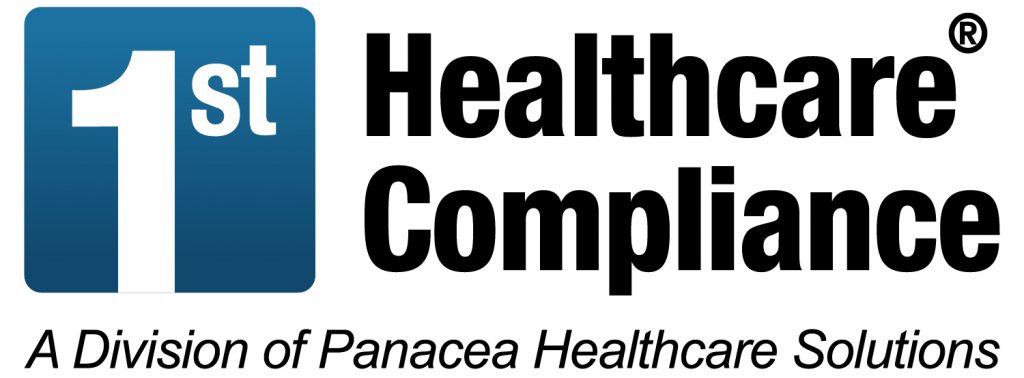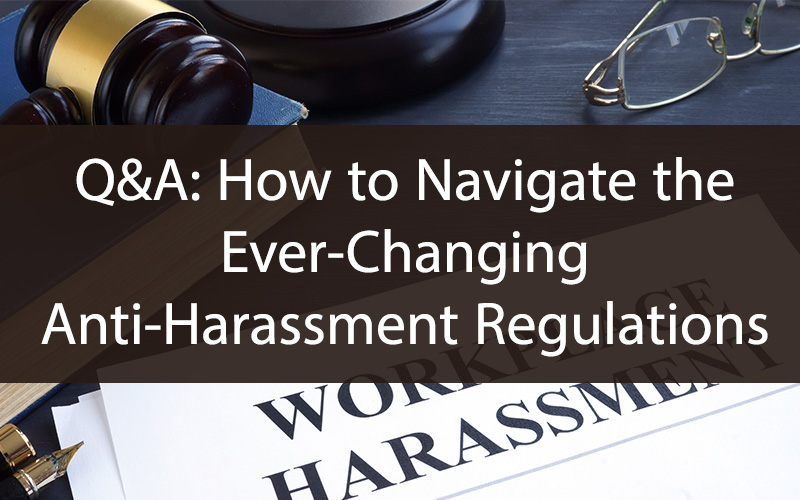Q&A: How to Navigate the Ever-Changing Anti-Harassment Regulations

Patricia M. Clendening, SHRM-SCP, GPHR, SPHR, President of HR Strategies, LLC, presented the webinar “How to Navigate the Ever-changing Anti-Harassment Regulations” recently and it now available on our YouTube Channel. Tricia Clendening answered many commonly asked questions on our blog concerning the theme of this webinar.
You mentioned that it was important to foster a professional courtesy work culture. Why is it important and how do you suggest we accomplish this?
Ask anyone in your workplace what treatment they most want from their colleagues and more often than not they will say that they want to be treated fairly, with respect and to feel valued for their contributions.
You can meet their needs very simply:
- Culture begins at the top, do everything you can to emulate the desired culture throughout the organization.
- Have an open-door policy that encourages people to express opinions and ideas and any concerns without fear of retaliation.
- Treat all people with courtesy, professionalism, and respect.
- Ensure accountability for noncompliance of policies regardless of an individual’s position.
- Ensure your company has policies and processes in place to protect individuals and help them navigate their way to resolution.
- Eliminate the old golden rule: “treat others as you want to be treated,” and implement the new golden rule: ‘treat others as they wish to be treated.”
Why are so many changes being made to state and local regulations regarding anti-harassment prevention?
I believe the changes are being made as a result of the significant harassment claim filings over the past several years. According to the EEOC they received 28,216 in 2016, 26,978 in 2017 and 26,699 in 2018 of claims of workplace harassment. In 2015 the EEOC convened a Select Task Force on the Study of Harassment in the Workplace to better understand why harassment persists in so many workplaces and what can help prevent it. They identified work-related factors associate with increased risk of sexual harassment and assault in the workplace. Some of the key risk factors include:
- Working for tips.
- Working in an isolated context.
- Lacking legal immigration status or having only a temporary work visa.
- Working in a male-dominated job.
- Working in a setting with significant power differentials and “rainmakers.”
What are the Sexual Harassment Costs to Companies?
Workplace harassment can result in substantial costs to companies, including legal costs if there are formal charges of harassment, costs related to employee turnover, and costs related to lower productivity from increased absences, lower motivation and commitment, and team disruption. While there are no recent estimates of the business costs of sexual harassment, earlier studies suggest these costs are substantial. Some of the economic burden of sexual harassment comes out of taxpayers’ pockets. According to the EEOC, in 2018 $134 million was paid out in monetary benefits alone.
What are the Sexual Harassment Costs to Individuals?
Sexual harassment and assault can affect individuals in a number of ways, including their mental and physical health, finances, and opportunities to advance in their careers. Some of the victims of harassment have experienced the following:
- Negative effects on mental and physical health
- Reduced opportunities for on-the-job learning and advancement
- Forced job change, unemployment and abandonment of well-paying careers
How should we address workplace sexual harassment?
Providing resources and training to prevent and address workplace sexual harassment and assault are critical to making workplaces safer for everyone.
The EEOC recommends the following interventions to help address sexual harassment and assault in the workplace:
- Employers should conduct assessments for the risk factors associated with sexual harassment and assault and conduct climate surveys to assess the extent to which harassment is a problem within their organization;
- Employers should adopt and maintain comprehensive anti-harassment policies, communicate the policies to employees frequently, offer multi-faceted reporting procedures, and “test” their reporting systems to determine their functionality;
- Employers should ensure that discipline for perpetrators of workplace harassment is prompt, consistent, and proportionate to the severity of the circumstance;
- Employers should train middle-management and supervisors on how to respond effectively to observed instances of sexual harassment;
- Employers should include workplace civility training and bystander intervention training;
Be sure to check out this webinar now on YouTube and check out our other HR resources, such as our online compliance training courses in the Basics of Family Medical Leave Act (FMLA) and Preventing and Addressing Workplace Harassment and Bullying.
 Patricia M. Clendening is a Global Professional in Human Resources (GPHR) and a Senior Professional in Human Resources (SPHR). She recently achieved SHRM-SCP, was the first in Delaware with this competency-based certification and the only person in Delaware to have all three designations. She has over 30 years of experience in Human Resources management with Fortune 100 corporations in a variety of Coaching, Change Management, Strategic Planning, Training and Development, and Employee Relations roles. In 2002 she launched HR Strategies, LLC to provide HR services to mid-size organizations.
Patricia M. Clendening is a Global Professional in Human Resources (GPHR) and a Senior Professional in Human Resources (SPHR). She recently achieved SHRM-SCP, was the first in Delaware with this competency-based certification and the only person in Delaware to have all three designations. She has over 30 years of experience in Human Resources management with Fortune 100 corporations in a variety of Coaching, Change Management, Strategic Planning, Training and Development, and Employee Relations roles. In 2002 she launched HR Strategies, LLC to provide HR services to mid-size organizations.
Tricia has been the recipient of numerous awards, regularly spends time on Capitol Hill meeting with government officials including Presidential Candidates, and has been instrumental in the writing of several pieces of legislation including HB360, Delaware’s new anti-harassment legislation.

